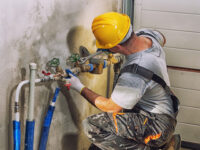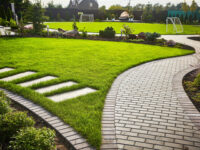The Evolving Role of Concrete in Modern Construction
Concrete Greensboro NC remains one of the most essential materials in construction. Its durability and versatility make it ideal for various structures. Builders rely on concrete for its strength and resistance to environmental factors. Over time, advancements have improved its performance and applications.
Modern concrete mixes include specialized additives. These enhance properties like strength, flexibility, and resistance to chemicals. Improved formulas allow concrete to withstand extreme weather conditions. Additives also reduce cracking and shrinkage.
Fiber-reinforced concrete has gained popularity. Fibers improve tensile strength and impact resistance. Different fibers, such as synthetic and steel, are used for various applications. This innovation increases structural durability and reduces repair costs.
Self-healing concrete is a breakthrough in material science. It contains bacteria that produce limestone when exposed to moisture. This process repairs small cracks automatically. Self-healing properties extend the lifespan of concrete structures.
Lightweight concrete is widely used in modern construction. It contains air pockets or lightweight aggregates. This reduces the overall weight without compromising strength. Lightweight concrete improves structural efficiency and reduces load-bearing requirements.
High-performance concrete offers superior strength and durability. It resists corrosion, abrasion, and chemical damage. Specialized curing methods enhance its properties. High-performance concrete is ideal for demanding construction environments.
Pervious concrete allows water to pass through its surface. This reduces runoff and improves drainage. It helps prevent flooding and replenishes groundwater. Pervious concrete is commonly used in environmentally sensitive areas.
Decorative concrete is used for aesthetic purposes. Pigments, stamps, and stains create unique patterns and colors. It is used in flooring, countertops, and facades. Decorative concrete combines functionality with visual appeal.
Concrete with recycled materials supports sustainability efforts. Recycled glass, plastic, and industrial waste are incorporated into the mix. This reduces environmental impact and conserves natural resources. Eco-friendly concrete aligns with green building practices.
Ultra-high-performance concrete sets new strength benchmarks. It contains fine particles and advanced bonding agents. This creates a dense and durable material. Ultra-high-performance concrete resists extreme pressures and environmental stress.
Concrete formwork technology has evolved significantly. Reusable and modular forms improve efficiency. Advanced formwork systems reduce labor costs and construction time. Proper formwork ensures consistent shaping and strength.
Concrete curing methods influence strength and durability. Proper moisture levels are maintained during the curing process. Steam curing accelerates setting time for faster construction. Effective curing prevents cracks and surface defects.
Concrete admixtures modify material properties. Plasticizers improve workability without increasing water content. Accelerators speed up the setting process. Retarders delay curing time in hot weather.
Shotcrete is applied using high-pressure spraying. It adheres well to uneven surfaces and complex shapes. Shotcrete is used for tunnel linings, pools, and retaining walls. The rapid application process reduces construction time.
Concrete pumping improves placement efficiency. High-pressure pumps transport concrete to hard-to-reach areas. This reduces labor requirements and increases project speed. Pumped concrete ensures uniform distribution and strength.
3D-printed concrete is transforming construction. Automated printing systems create complex structures with precision. This reduces material waste and labor costs. 3D printing allows for unique architectural designs.
Concrete strength is tested through compression and flexural tests. These measure the ability to withstand loads and bending. Proper testing ensures compliance with safety standards. Strength assessments guide material selection and design.
Concrete slabs are reinforced with steel mesh or rebar. Reinforcement prevents cracking and increases load-bearing capacity. Proper placement of reinforcement ensures structural integrity. Reinforced slabs support heavy traffic and equipment.
Concrete joints allow for controlled movement. Expansion and contraction joints prevent cracking from thermal changes. Proper joint placement ensures long-term stability. Joints reduce internal stress and surface damage.
Concrete sealers protect surfaces from moisture and stains. Sealers enhance durability and appearance. Penetrating sealers provide deep protection. Surface sealers create a protective barrier against wear.
Concrete polishing creates a smooth, reflective surface. Mechanical grinding removes imperfections and enhances appearance. Polished concrete resists stains and wear. It is popular in commercial and industrial spaces.
Concrete overlays restore worn surfaces. Thin layers of concrete are applied to existing slabs. Overlays improve strength and appearance. Decorative options include textures and colors.
Concrete countertops are becoming more popular in interior design. Custom molds allow for unique shapes and finishes. Sealed surfaces resist stains and heat. Concrete countertops combine style with durability.
Concrete staircases are both functional and aesthetic. Precast and poured-in-place options are available. Reinforcement ensures load-bearing strength. Finishes include polished, stained, or textured surfaces.
Concrete foundations support the entire structure. Proper soil preparation and reinforcement ensure stability. Foundation cracks can compromise structural integrity. Professional installation ensures long-term performance.
Concrete walls provide strength and sound insulation. Reinforced concrete walls resist lateral pressure. Insulated concrete forms improve energy efficiency. Wall finishes range from smooth to textured.
Concrete footings distribute weight evenly. Proper footing depth prevents settling and shifting. Reinforcement ensures load-bearing capacity. Concrete footings provide a stable base for structures.
Concrete bridges are designed for strength and durability. Precast segments improve construction efficiency. Reinforced and post-tensioned concrete increases load capacity. Proper maintenance extends bridge lifespan.
Concrete dams control water flow and storage. Mass concrete placement resists hydraulic pressure. Spillways and gates regulate water release. Dams protect communities from flooding and drought.
Concrete roads provide smooth and durable surfaces. Joint spacing and reinforcement reduce cracking. Proper curing ensures longevity and performance. Concrete roads resist heavy traffic and weather conditions.
Concrete tunnels provide secure transportation routes. Shotcrete and precast segments reinforce tunnel walls. Proper ventilation and drainage improve safety. Tunnels resist soil pressure and groundwater intrusion.
Concrete parking structures withstand heavy loads. Reinforced decks and columns improve strength. Drainage systems prevent water accumulation. Concrete surfaces resist oil and chemical stains.
Concrete retaining walls prevent soil erosion. Proper drainage and reinforcement ensure stability. Wall height and thickness match soil pressure requirements. Retaining walls protect properties and landscapes.
Concrete stairs in public spaces endure heavy foot traffic. Tread depth and riser height meet safety standards. Reinforcement and anti-slip finishes improve safety. Proper design prevents wear and damage.
Concrete floors resist moisture and impact. Polished and sealed finishes improve appearance and durability. Reinforcement reduces cracking under heavy loads. Concrete floors are ideal for industrial and commercial spaces.
Concrete curbs define road edges and sidewalks. Precast and poured-in-place options are available. Curbs prevent soil erosion and control water flow. Proper installation ensures straight and durable lines.
Concrete patios enhance outdoor living spaces. Stamped and stained finishes create decorative effects. Reinforcement improves load capacity. Proper drainage prevents water pooling and surface damage.
Concrete fireplaces provide heat and ambiance. Fire-resistant concrete withstands high temperatures. Decorative finishes enhance visual appeal. Proper ventilation ensures safe operation.
Concrete columns support vertical loads. Reinforced concrete resists bending and buckling. Proper placement and curing ensure strength. Columns are essential for multi-story buildings.
Concrete arches distribute loads efficiently. Reinforcement improves tensile strength. Proper formwork ensures consistent shaping. Concrete arches combine structural integrity with aesthetic appeal.
Concrete sculptures offer artistic expression. Molds and carving techniques create detailed forms. Sealed surfaces resist weathering and damage. Concrete sculptures enhance public and private spaces.
Concrete pipes transport water and waste. Reinforced concrete resists pressure and corrosion. Proper joint sealing prevents leaks. Concrete pipes provide long-lasting performance.
Concrete cladding improves building facades. Lightweight panels reduce structural load. Textured and colored finishes enhance aesthetics. Cladding improves thermal and sound insulation.
Concrete stairs in industrial settings resist wear and impact. Reinforcement and anti-slip finishes improve safety. Proper rise and tread depth enhance usability. Concrete stairs provide long-term performance.
Concrete bridges support heavy traffic loads. Reinforced and pre-stressed concrete improves durability. Expansion joints reduce stress from thermal changes. Concrete bridges ensure safe and reliable transportation.
Concrete water tanks store and supply water. Reinforced concrete resists pressure and chemical exposure. Proper sealing prevents leaks. Concrete tanks provide long-term storage solutions.
Concrete platforms provide stable work surfaces. Reinforcement ensures load-bearing strength. Proper curing and sealing improve durability. Platforms resist weathering and mechanical stress.
Concrete continues to evolve with technological advancements. New materials and methods enhance performance and sustainability. Professional installation ensures strength and longevity. Concrete remains a foundation for modern infrastructure.






